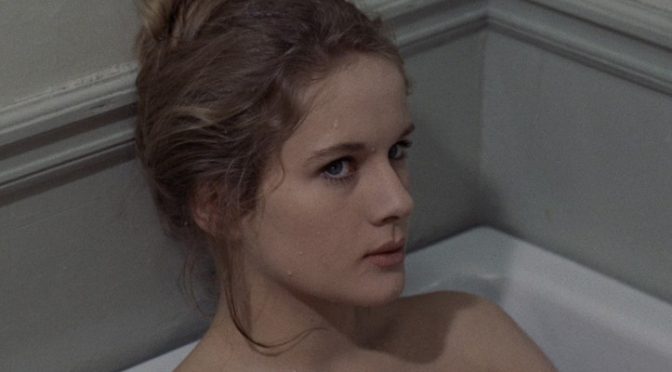UNE FEMME DOUCE (1969) features one of Robert Bresson’s sharpest, bluntest images on the degradation of the spiritual: A young student, Elle (Dominique Sandra), visits a pawnbroker, Luc (Guy Frangin), and trades in a golden gross with a porcelain Jesus, in the throes of the crucifixion, mounted on it. Luc dismounts Jesus from the cross, pawning the gold, but hands the Christ statuette back to her. Bresson couldn’t be any clearer, so when a character later intones that they “tried to pray, but […] could only think”, the film has already cornered the viewer with its view of a life meaningful only in its absences: the absence of God and the absence of love.
Not that love was ever a possibility here. After pawning some possessions, Elle marries Luc, his proposal sounding more like a command, and his repeated promise that he can make her happy sounds less like a comforting invitation and more like a threat: he’ll force her into his view of her happiness. He treats her as though she’s another item to pawn. But we already know how this ends. UNE FEMME DOUCE begins with a quick flurry of images denoting Elle’s suicide, which the film will return to again with a calm certainty amounting to devastation. A maid, Anna (Jeanne Lobre), opens a door in their apartment; a table on the balcony falls down; a white scarf floats down the side of the building; and then Elle’s body is still on the pavement, blood pooling by the site of impact, and a gathering of shoes around the body.
From here on the film cuts between the aftermath, Luc telling Anna the particulars of how they arrived at the present moment, with Elle’s body on the bed next to them, and the events narrated; these two areas are stitched together in an immaculate, complicating fashion: Luc’s narrative to Anna is self-pitying, full of embellishments, minimising her at every turn; whereas the drama’s enactment, and at a certain level, the compositions of Bresson’s images, contradict him constantly: what they communicate is the tale of a woman’s confiscation and eventual destruction.
Elle is a voracious reader, imbibing literature, poetry, natural sciences. Museums and zoos fascinate her, both as fuel for her curiosity about everything “being made from the same material”, and because she must feel some kinship with the beings behind the bars. On one zoo visit, the framing answers many of the questions we might have about the pair’s feelings: in a conversation rendered in shot-reverse-shot fashion, they sit on a bench together, facing each other at an angle; Bresson frames Elle as caught between Luc’s head and his arm stretched along her back, but Luc is framed at one side of her, on her right, and the left side of the frame is free of his presence. The gulf between them, and their views of each other, made visible in two images.
The distance between the pair is accentuated by Bresson’s exacting schemes for performances and editing. Bresson referred to his actors as ‘models’, and his method requires simplicity, unaffectedness, and direct relation to how the action or emotion being performed refers to lived reality. The director required of his models a great number of takes, in order that the performance attain the air of a thing done for its own purpose. Therefore the performances are cold even for a film about cold people; both Sandra and Frangin wear a mask-like solemnity, and any deviation from stillness has the effect of a rupture. The editing too has its part in separating Elle and Luc, since it obliterates a sense of shared space: Bresson cuts to isolated parts, from parts of a body to objects, such as, in A MAN ESCAPED (1956) and PICKPOCKET (1959), concentrated observations of the work of hands. In those films the minute details make up a whole: in UNE FEMME DOUCE there are only minute details.
The film is adapted from Fyodor Dostoevsky’s short story A Gentle Creature, and Bresson’s dispassionate style affords him a moral clarity approaching the Russian author’s. It’s the question that launched a thousand dissertations: is Bresson as dispassionate as his style? Perhaps he is. But the reservation and detachment of his films is the reason for their clarity, their precision, visual, auditory, literary, and moral. The effects of UNE FEMME DOUCE, those that seem most difficult, convey to a viewer access to the world’s negations, which intimates, more than anything out of Dostoevsky, something like the matter of Eugenio Montale’s lines on the subject of the negative: ‘This, today, is all that we can tell you: / What we are not, what we do not want.’

